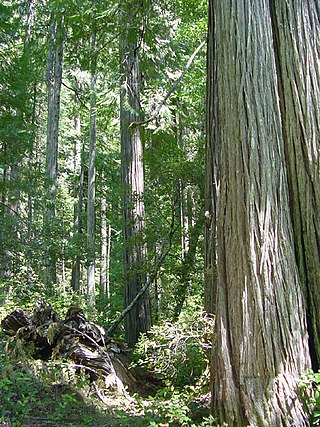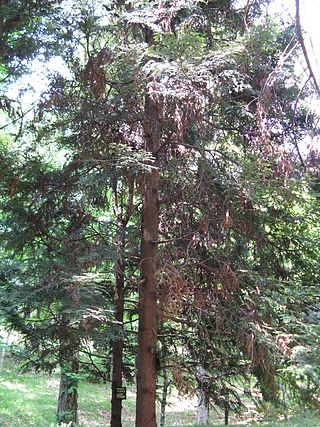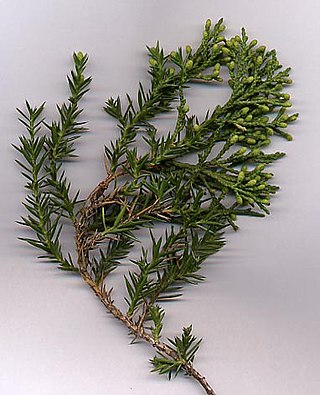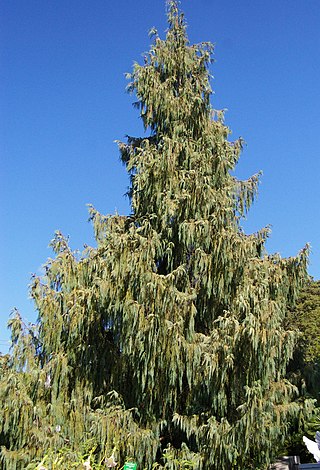
Gentiana acaulis, the stemless gentian, or trumpet gentian, is a species of flowering plant in the family Gentianaceae, native to central and southern Europe, from Spain east to the Balkans, growing especially in mountainous regions, such as the Alps and Pyrenees, at heights of 800–3,000 m (2,625–9,843 ft).

Geranium maderense, known as giant herb-Robert or the Madeira cranesbill, is a species of flowering plant in the family Geraniaceae, native to the island of Madeira. It is sometimes confused with another Madeira endemic, Geranium palmatum.

Chamaecyparis lawsoniana, known as Port Orford cedar or Lawson cypress, is a species of conifer in the genus Chamaecyparis, family Cupressaceae. It is native to Oregon and northwestern California, and grows from sea level up to 4,900 feet (1,500 m) in the valleys of the Klamath Mountains, often along streams.

Thujopsis is a genus of conifers in the cypress family (Cupressaceae), the sole member of which is Thujopsis dolabrata. It is endemic to Japan, where it is named asunaro (あすなろ). It is similar to the closely related genus Thuja (arborvitae), differing in the broader, thicker leaves and thick cones.

Juniperus chinensis, the Chinese juniper is a species of plant in the cypress family Cupressaceae, native to China, Myanmar, Japan, Korea and the Russian Far East. Growing 1–20 metres tall, it is a very variable coniferous evergreen tree or shrub.

Cupressus arizonica, the Arizona cypress, is a North American species of tree in the cypress family Cupressaceae, native to the southwestern United States and Mexico. Populations may be scattered rather than in large, dense stands.

Microbiota is a monotypic genus of evergreen coniferous shrubs in the cypress family Cupressaceae, containing only one species, Microbiota decussata. The plant is native and endemic to a limited area of the Sikhote-Alin mountains in Primorskiy Krai in the Russian Far East. Microbiota is not to be confused with the range of microorganisms of the same name. The genus name was derived from micro-, meaning "small", + Biota, the genus name for a closely related conifer, a species formerly called Biota orientalis, now renamed Platycladus orientalis.

Erica cinerea, the bell heather, is a species of flowering plant in the heath family Ericaceae, native to western and central Europe.

Picea smithiana is a species of evergreen tree in the family Pinaceae family It is referred to by the common names morinda spruce and West Himalayan spruce, and is a spruce native to the western Himalaya and adjacent mountains, from northeast Afghanistan, northern Pakistan, India to central Nepal. It grows at altitudes of 2,400-3,600 m in forests together with deodar cedar, blue pine and pindrow fir.

Juniperus squamata, the flaky juniper, or Himalayan juniper is a species of coniferous shrub in the cypress family Cupressaceae, native to the Himalayas and China.

Cupressus cashmeriana, the Bhutan cypress or Kashmir cypress, is a species of evergreen conifer native to the eastern Himalaya in Bhutan and adjacent areas of Arunachal Pradesh in northeastern India. [ Now in vulnerable category, IUCN list retrieved in 2006 ]. It is also introduced in China and Nepal. It grows at moderately high altitudes of 1,250–2,800 metres (4,100–9,190 ft).

Prunus incisa, the Fuji cherry, is a species of flowering plant in the family Rosaceae, which gets its scientific name from the deep incisions on the leaves. It is an endemic species in Japan and grows wild in Kantō, Chūbu and Kinki regions. It is called the Fuji cherry because it grows in particular abundance around Mount Fuji and Hakone. A dainty slow-growing, early white-flowering cherry tree, this century-old cultigen from Hondo, Japan is highly regarded as an ornamental but the wood has no industrial value. It is hardy to -20 °C, and crossed with Prunus speciosa, has yielded the cultivar Prunus 'Umineko'. It is in the ornamental section Pseudocerasus of the cherry subgenus Cerasus of the genus Prunus. Ma et al. classified it in a group with Prunus nipponica.
Exacum caeruleum is a species of plant in the Gentianaceae family. It is endemic to Yemen. Its natural habitat is subtropical or tropical dry shrubland.

Genista aetnensis, the Mount Etna broom, is a species of flowering plant in the legume family Fabaceae. It is a large shrub or small tree endemic to Sicily and Sardinia where it is associated with sunny, open landscapes and poor, stony soil. It is a very common constituent of the garigue plant communities, Mediterranean shrubby vegetation, around the lower slopes of Mount Etna, hence its Latin specific epithet aetnensis.

Amelanchier laevis, the smooth shadbush, smooth serviceberry or Allegheny serviceberry, is a North American species of tree in the rose family Rosaceae, growing up to 9 metres (30 ft) tall. It is native to eastern Canada and the eastern United States, from Newfoundland west to Ontario, Minnesota, and Iowa, south as far as Georgia and Alabama.

Erica lusitanica is a European species of flowering plant in the family Ericaceae, known by the common names Portuguese heath and Spanish heath.

Acer palmatum, commonly known as Japanese maple, palmate maple, or smooth Japanese maple (Korean: danpungnamu, 단풍나무, Japanese: irohamomiji, イロハモミジ, or momiji,, is a species of woody plant native to Korea, Japan, China, eastern Mongolia, and southeast Russia. Many different cultivars of this maple have been selected and they are grown worldwide for their large variety of attractive forms, leaf shapes, and spectacular colors.

Clethra barbinervis, the Japanese clethra, is a species of flowering plant in the family Clethraceae. It is native to eastern Asia, where it is found in southern China, Korea, and Japan. Its natural habitat is in open mountain forests. It is a common species in Japan, and is often found in disturbed secondary forests.

Halesia carolina, commonly called Carolina silverbells or little silverbells, is a species of flowering plant in the family Styracaceae, native to the southeastern United States.

Vaccinium cylindraceum, known by its common names such as Azores blueberry, is a semi-deciduous species of Vaccinium endemic to the Azores. It has gained the Royal Horticultural Society's Award of Garden Merit as an ornamental.




















